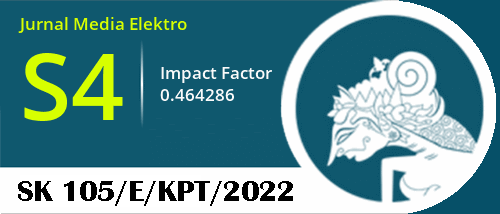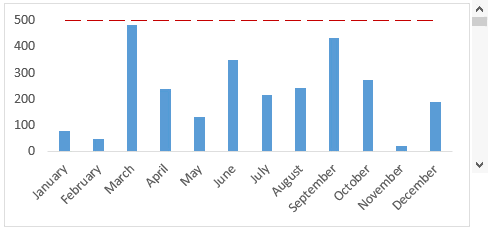Effect of KMnO₄ Concentration on the Bioelectricity of a Double-Chamber Microbial Fuel Cell Using Cocoa Pod Husk Waste as Substrat
Abstract
The increasing use of fossil fuels for electricity generation leads to scarcity and greenhouse gas emissions, necessitating a solution in the form of a transition to environmentally friendly renewable energy. One renewable energy source that is currently being developed is the Microbial Fuel Cell (MFC), which utilizes bacterial metabolism to generate electrical energy. MFC generally consists of two chambers: an anode chamber containing microorganisms and substrates, and a cathode chamber containing an electrolyte solution. The organic material used as a substrate in the anode chamber of the MFC in this study is cocoa pod husk waste, while the electrolyte solution in the cathode chamber is potassium permanganate (KMnO₄). This study will analyze the effect of KMnO₄ concentration on the bioelectricity of the cocoa pod husk MFC, including current, voltage, and power density. The KMnO₄ concentrations used are 0.02 M, 0.03 M, and 0.04 M. The bioelectricity testing results show that the KMnO₄ concentration in the cathode chamber affects the system's performance, with a 0.03 M concentration producing the highest current and power density.
Downloads
References
M. Harimbawa, "Persistensi Bahan Bakar Fosil: Analisis Path Dependence dalam Bauran Konsumsi-Energi Indonesia Periode 1980–2015," Jurnal Kebijakan Ekonomi, vol. 11, no. 2, p. 5, 2016. [Online]. Available: https://scholarhub.ui.ac.id/jke/vol11/iss2/5/.
F. D. Romadhon and R. Subekti, "Analisis Pengaturan Energi Terbarukan Dalam Kendaraan Berbasis Elektrik Untuk Mendukung Perlindungan Lingkungan (Analisis Komparatif Antara Indonesia, Brazil, Dan Pakistan)," Jurnal Pacta Sunt Servanda, vol. 4, no. 1, pp. 177-190, 2023. [Online]. Available: https://ejournal2.undiksha.ac.id/index.php/JPSS/article/view/2049.
A. Santoso, N. Suwedi, R. A. Pratama, and J. P. Susanto, "Energi terbarukan dan pengurangan emisi gas rumah kaca dari palm oil mill effluent," Jurnal teknologi lingkungan, vol. 18, no. 1, pp. 88-95, 2017. [Online]. Available: https://www.academia.edu/download/102488820/1493.pdf.
I. Wahyuni, H. Heriyono, A. Aisyah, M. Baharuddin, and I. I. Patunrengi, "Potensi Energi Listrik dari Microbial Fuel Cell (MFC) Menggunakan Substrat Molase dan Bakteri Pseudomonas sp," ALCHEMY: Journal of Chemistry, vol. 10, no. 1, pp. 8-13, 2022, doi: https://doi.org/10.18860/al.v10i1.12154.
B. Ibrahim and S. D. Hardiningtyas, "Kinerja Pembangkit Biolistrik Salt Bridge Mirrobial Fuel Cell Variasi Rasio Karagenan-Karboksimetil Selulosa," Jurnal Pengolahan Hasil Perikanan Indonesia, vol. 25, no. 2, pp. 214-225, 2022, doi: https://doi.org/10.17844/jphpi.v25i2.39872.
F. A. Prayogo, A. Suprihadi, and B. Raharjo, "Microbial Fuel Cell (MFC) Menggunakan Bakteri Bacillus Subtilis dengan Substrat Limbah Septic Tank Serta Pengaruhnya Terhadap Kualitas Limbah," Jurnal Akademika Biologi, vol. 6, no. 2, pp. 17-25, 2017. [Online]. Available: https://ejournal3.undip.ac.id/index.php/biologi/article/view/19530.
U. Mardiana, "Microbial Fuel Cell Berbasis Yeast Saccharomyces cerevisiae," Jurnal Kesehatan Bakti Tunas Husada: Jurnal Ilmu-ilmu Keperawatan, Analis Kesehatan dan Farmasi, vol. 14, no. 1, pp. 56-62, 2015.
S. Pramono and E. Rani, "Pengaruh Penambahan Bakteri Eschericia Colio157: H7 Terhadap Produksi Energi Listrik Pada Sel Bahan Bakar Urine," Jurnal Neutrino: Jurnal Fisika dan Aplikasinya, 2014, doi: https://doi.org/10.18860/neu.v0i0.2586.
R. N. A. Sejati, Rasyidah, and R. A. Nasution, "PEMANFAATAN LIMBAH CAIR TEMPE DENGANPENAMBAHAN Lactobacillus acidophilus MENGGUNAKAN MICROBIAL FUEL CELL(MFC) MENJADI BIOLISTRIK," BIO-CONS: Jurnal Biologi dan Konservasi vol. 6, no. 1, pp. 278-287, 2024. [Online]. Available: https://jurnal.unipar.ac.id/index.php/biocons/article/view/1808/1606.
A. K. Dewi, G. Djajakirana, and D. A. Santosa, "Potensi Limbah Tahu untuk Menghasilkan Listrik pada Tiga Model Sistem Microbial Fuel Cell (MFC)," Jurnal Ilmu Tanah dan Lingkungan, vol. 22, no. 1, pp. 29-34, 2020, doi: https://doi.org/10.29244/jitl.22.1.29-34.
S. D. N. Aini, M. Marlinda, and W. Wahyudi, "Pengaruh Variasi Massa Limbah Kulit Pisang Terhadap Produksi Biolistrik Microbial Fuel Cell (MFC)," Jurnal Inovasi Global, vol. 2, no. 6, pp. 649-658, 2024, doi: https://doi.org/10.58344/jig.v2i6.109.
B. A. Nugraha and T. P. Sopandi, "Pengolahan Limbah Kulit Jeruk Sebagai Sumber Energi Terbarukan Di Desa Selorejo, Kabupaten Malang: Literature Review," Jukung (Jurnal Teknik Lingkungan), vol. 8, no. 1, 2022, doi: https://dx.doi.org/10.20527/jukung.v8i1.12965.
F. Fitriana, M. A. Auliq, F. Akbar, and Z. Mubarok, "BIOELECTRICITY OF COCOA POD WASTE AS A SUBSTRATE IN A DOUBLE CHAMBER MICROBIAL FUEL CELL," Jurnal Media Elektro, pp. 93-99, 2023, doi: https://doi.org/10.35508/jme.v12i2.12624.
I. Muftiana, L. Suyati, and D. S. Widodo, "The Effect of KMnO4 and K3 [Fe (CN) 6] Concentrations on Electrical Production in Fuel Cell Microbial System with Lactobacillus bulgaricus Bacteria in a Tofu Whey Substart," Jurnal Kimia Sains dan Aplikasi, vol. 21, no. 1, pp. 49-53, 2018. [Online]. Available: https://pdfs.semanticscholar.org/b60f/da10a5061700e8ae5eb44b42643b2f358793.pdf.
L. Utami, L. Lazulva, and Y. Fatisa, "Electricity production from peat water uses microbial fuel cells technology," Indonesian Journal of Chemical Science and Technology, vol. 2, no. 1, pp. 55-60, 2020. [Online]. Available: https://www.neliti.com/publications/332682/electricity-production-from-peat-water-uses-microbial-fuel-cells-technology.
R. Campos-Vega, K. H. Nieto-Figueroa, and B. D. Oomah, "Cocoa (Theobroma cacao L.) pod husk: Renewable source of bioactive compounds," Trends in Food Science & Technology, vol. 81, pp. 172-184, 2018, doi: https://doi.org/10.1016/j.tifs.2018.09.022.
N. Mufida and A. H. P. Yuniarto, "PEMANFAATAN LIMBAH TAHU UNTUK MENGHASILKAN ENERGI LISTRIK DENGAN SISTEM MFC MENGGUNAKAN BAKTERI LACTOBACILLUS BULGARICUS," PHYDAGOGIC: Jurnal Fisika dan Pembelajarannya, vol. 6, no. 2, pp. 80-85, 2024, doi: http://orcid.org/0000-0002-8972-2186.

This work is licensed under a Creative Commons Attribution-ShareAlike 4.0 International License.
This work is licensed under CC BY-SA 4.0

 Fitriana Fitriana(1*)
Fitriana Fitriana(1*)











